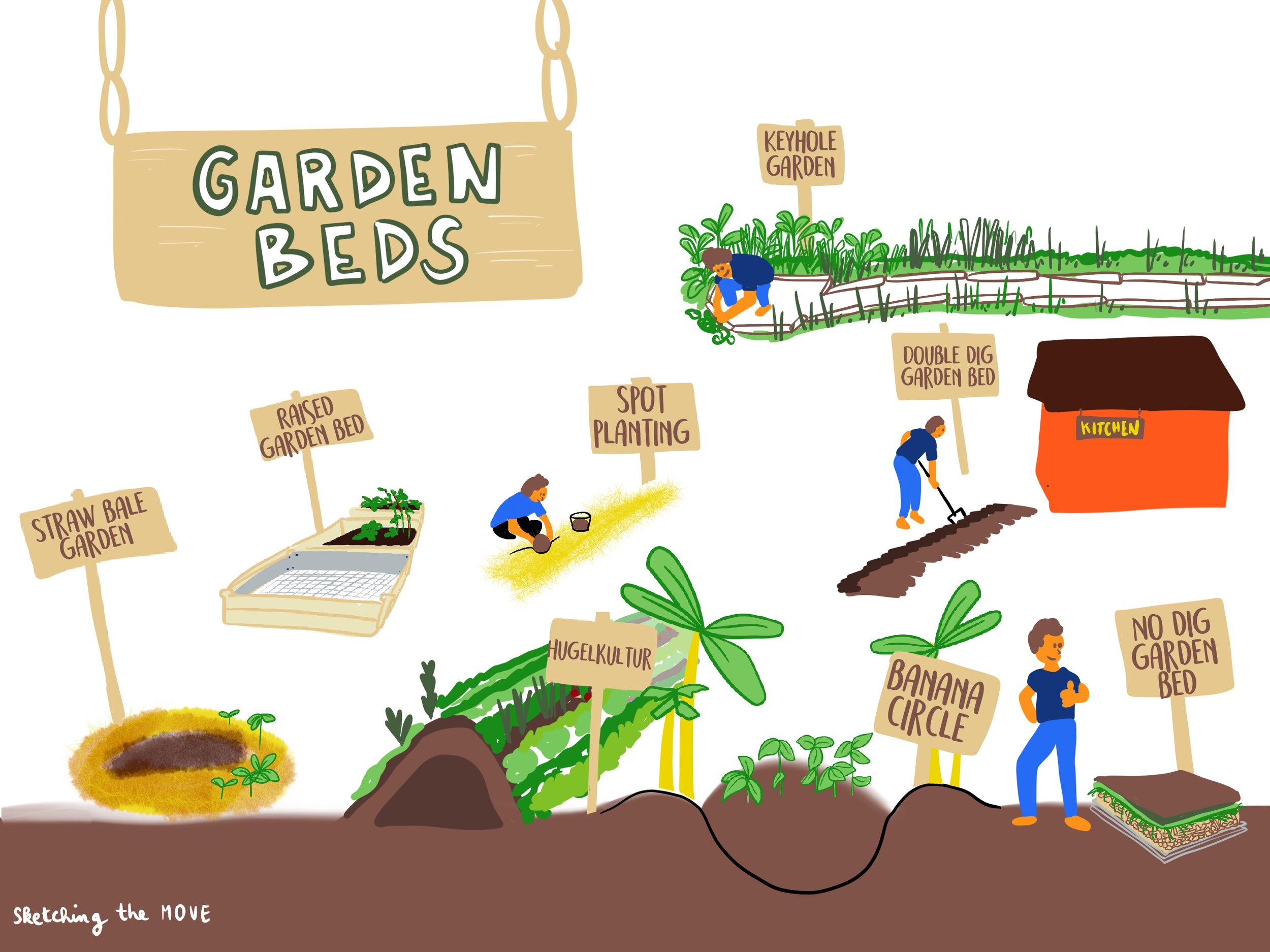Session 12: Permaculture for vegetable gardening (Part 1)
COVID-19 Community Resilience & Permaculture Course
Session 12:
Permaculture for vegetable gardening (Part 1)
What is the optimal garden bed to grow vegetables?
Vegetable gardening is one part of the entire permaculture cosmos. For the people coming from gardening and looking for new techniques to increase their yield, it is the bounding link and their access door. Once they entered they will see that permaculture has way more to offer than just boosting vegetable production. Permaculture is actually offering a holistic system design system that works with interlinkages between elements.
Today's session is about showcasing different permaculture garden bed techniques to grow your own vegetables. After finishing part 1 of this session you will be introduced to:
No-till garden beds,
Double Dig garden beds,
Raised garden beds,
Hugelkultur,
In part 2 of this session, we will introduce you to:
Straw bell garden beds,
Spot planting,
Keyhole garden beds, and
Banana circle
Video for Session 12 Permaculture for vegetable gardening (Part 1)
Like this video and subscripe to flowful youtube channel!
Least Change for the Greatest Effect
We are looking for methods that are balancing human needs and the regeneration of ecosystems. As we try to work with nature, we are mindful and aware that we try to change as little as possible to get our needs met by the ecosystem. Besides, it is also about the efficient use of energy and resources; we want to find a way that requires a relatively low input of human energy and resources.
“Least Change for the Greatest Effect”
Understand the system you are working with
Understanding the different ways of creating garden beds including its benefits and disadvantages will save you a lot of energy, support the plants to develop, and increase your yield. By understanding the system you are working with while simultaneously implementing fitting elements, you can strengthen and establish ecosystems. Your efforts will help to enrich soil fertility, create habitat, and reduce the amount of necessary maintenance.
There are a lot of garden bed systems and terms out there. No-dig garden, no-till garden, double-digging garden beds, sheet mulching beds, lasagna beds, hugelkultur, or raised beds are just some of the most common approaches to growing food. All of them are linking back to the principle of using the least destructive method while increasing soil fertility. We will introduce you to 8 relevant permaculture garden beds or gardening techniques.
How to design your path in a vegetable garden? The relationship between bed and pat
When designing your vegetable garden you want to ensure that you can reach all elements within your garden beds without stepping on your garden beds and compacting the soil. However, you also want to maximize bed growing space. Finding your optimal path to bed set-up for your location and your needs is the main key design driver for your paths.
In the ideal site, you have the possibility to stay on the path and reach out to the middle of the bed easily. Thus, it needs to suit you when it comes to maintenance and harvesting without stepping on the beds. When planning the path between the beds it is important to have the size of your wheelbarrow or other tools in mind that you might have to transport close to the beds. Some might be wider so-called service paths and others are just for maintenance and can be smaller. In the end, you should end up in a high bed to path ratio. As always in permaculture, you want to increase the function of an element. Paths are:
access ways,
habitat for mushrooms if mulched
create fertile soil if mulched
managing water (drainage)
structuring your diversity
Different garden beds for vegetable growing in Permaculture
Let’s dive into the different forms of vegetable gardening:
Permaculture garden beds by sketching the move
No-dig / no-till gardening & lasagna garden beds / sheet mulching (Natural farming and permaculture)
These four different names have the same concept behind them. The main idea of this technique is it supports the gardener to obtain a yield while enriching the soil. It is a great pioneering technique as you are building new topsoil on top of compacted or poor soil. Due to the different layers, it is a perfect tool to turn lawns or grasses into a garden. It is following the idea of a no-dig garden as you are adding material establishing a soil-food web that is turning and mixing the different layers into healthy and rich topsoil. By adding more organic matter you support the aeration of the soil without tilling.
When to use?
Ideal for already increased soil condition, and also possible to use as pioneering in rich soil areas. It can also be used under poor soil conditions.
Advantage: Soil structure will not be destroyed at all & natural processes are doing the work.
Disadvantage: Might take some time before the amount of organic matter in the initial topsoil will increase.
How to do it?
The main idea is to not take out existing ground cover (such as grass, weeds, etc). while still protecting your new vegetable plants and reducing competition for nutrients, sun, and water - turning the current growth into soil and increasing organic matter in your garden beds. This method uses 5 different layers - cardboard (1), brown material such as leaves, shredded newspaper, etc. (2), green material such as kitchen waste, garden and grass clippings, etc. (3), compost or topsoil (4), and mulch (5). We will cover the layering garden bed in more detail in one of the next sessions.
Double dig garden beds (Permaculture)
Double dig gardens are often used for intensively used areas such as kitchen gardens. Double dig garden beds require high energy input and the technique is also mixing up and disturbing the soil-food web. Corn and other crops are developing well in a double dig garden bed.
When to use?
Intensively used garden plots like main kitchen gardens and areas where we have little topsoil and a need to enrich subsoil while adding organic matter. Advantage: Fast way of adding soil fertility, ensuring the right soil conditions for plants with a high demand for nutrients.Disadvantage: temporarily disturbs soil life
How to apply double dig gardening?
The layer of topsoil is temporarily removed from the beds. Then, the subsoil beneath it is loosened with a fork and organic matter is mixed into the subsoil. After finishing the subsoil, the topsoil is replaced. The final steps follow the same approach as the no-dig garden - the beds are covered over with a layer of organic compost and finally topped off mulching material.
Raised garden beds (Permaculture)
Raised beds are very popular in gardening and permaculture. A raised bed is a planting bed that sits on top of your existing soil. Reasons for using raised garden beds are diverse, but whenever thinking about a raised bed it is helpful to ask yourself why an artificial and exposed growing spot is more beneficial than a natural way of putting your vegetables directly in the ground, linking back to the principle we started the session with - “least change for the greatest impact
”When to use Raised beds?
Raised beds are great for urban areas as you can create them on concrete or any given surface. Furthermore, they also help to work around areas with bad drainage. Raised beds are great for inclusive gardening as it allows access for wheelchairs or people with back pain.
Advantage: Free draining and easy to use in industrial, urban, or other areas with bad soil conditions. They are flexible and movable and, therefore impermanent. They are high in fertility and allow barrier-free gardening. A raised garden bed is good for root crops (such as potatoes and onions) and at the same time good for tomatoes and leafy greens.
Disadvantage: Requires more preparation and more resources (including financial capital). The plants are more exposed to climate conditions, sun and wind. Might reduce growing season if exposed to wind. More water is needed.
How to build a raised garden bed?
The big difference of a raised garden bed to a no-dig garden is that you are giving external support to your layers. This frame allows you to put more layers, organic matter, or pre-mixed compost on your beds. 2 steps are needed to build a raised garden bed: Build and place your frame according to your designed height (using wood, stones etc.) Fill the space either with a mix of compost and topsoil or follow the no-dig garden layering process until the raised bed is filled.
Hugelkultur bed (Permaculture)
Planting on top and on the sides of a Hugelkultur increases usable surface area. After planting on the Hugelkultur bed, watering is essential to ensure a good start for the plants. In Session 4 of the Permaculture and Resilience Online Course, we covered the implementation of a Hugelkultur in more detail. Check it out
When to use?
Hugelkultur is mainly used if you want to create a garden bed that is releasing fertility back into the soil for a long time (up to 20 years). Advantage: Releases soil fertility over a long period. More surface area; creates a microclimate. It helps retain moisture on-site and increases drainage. Disadvantage: Initial destruction of existing soil life and structure, high energy input.
How to Build a Hugelkultur bed?
Hugelkultur beds are large, layered compost piles covered with compost or topsoil, just like raised beds. However, the big difference is the amount of wood that is put into this specific garden bed. The first layer, sometimes even partly buried, is made up of big logs and wooden material. They will act as a fertile storage and will increase soil fertility over the years. The second layer is smaller branches, followed by small sticks and twigs. As a final layer, everything will be covered with topsoil and mulch. For more details go back to session 4 Implementing a Hugelkultur garden bed.
What comes next?
In part 2 of this session, we will introduce you to:
Straw bell garden beds,
Spot planting,
Keyhole garden beds, and
Banana circle
Learning exercise
Go out and implement one of the introduced garden beds in your area or just do a online research about how to make the different gardens bed fitting into your climate zone.



